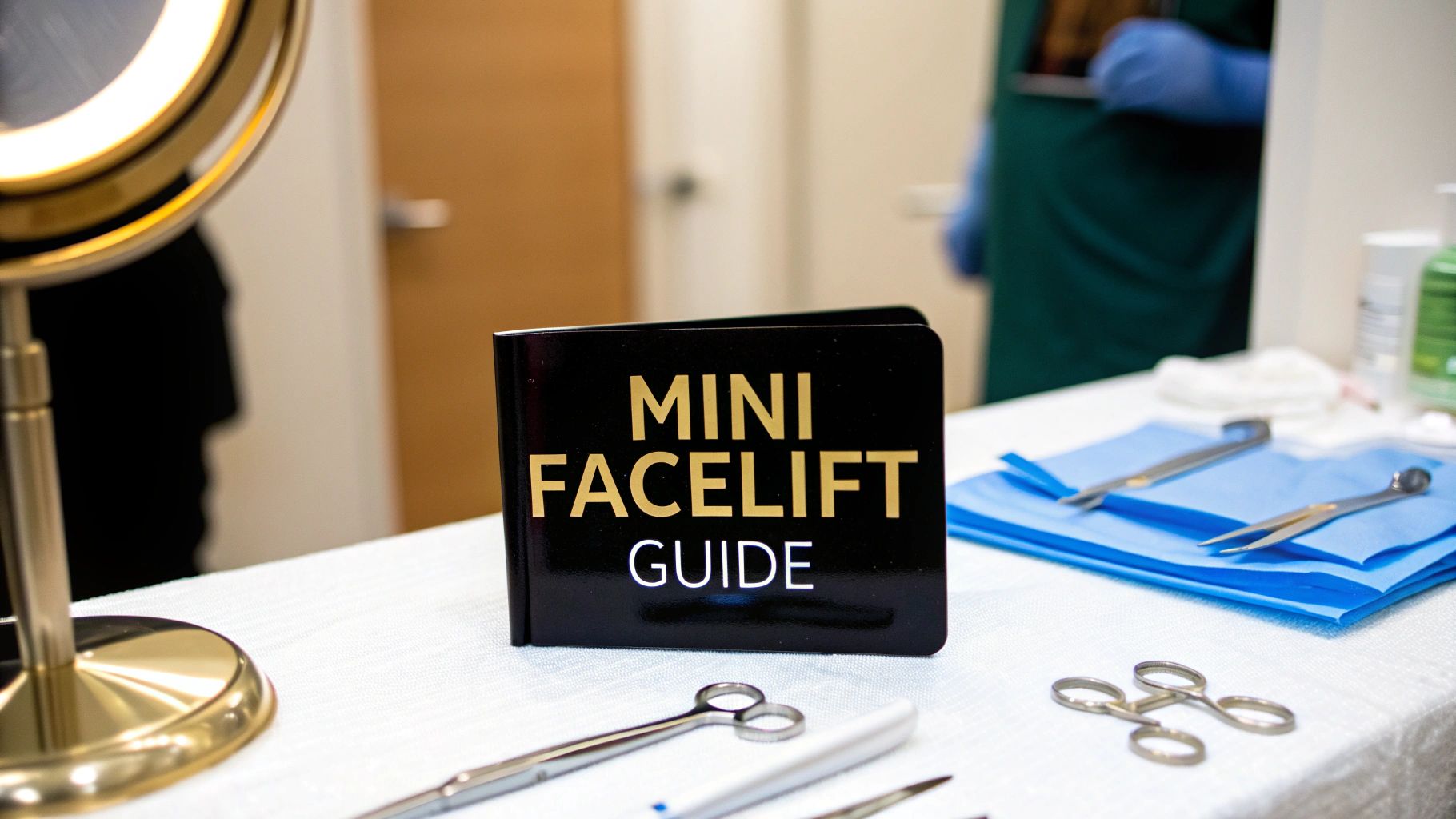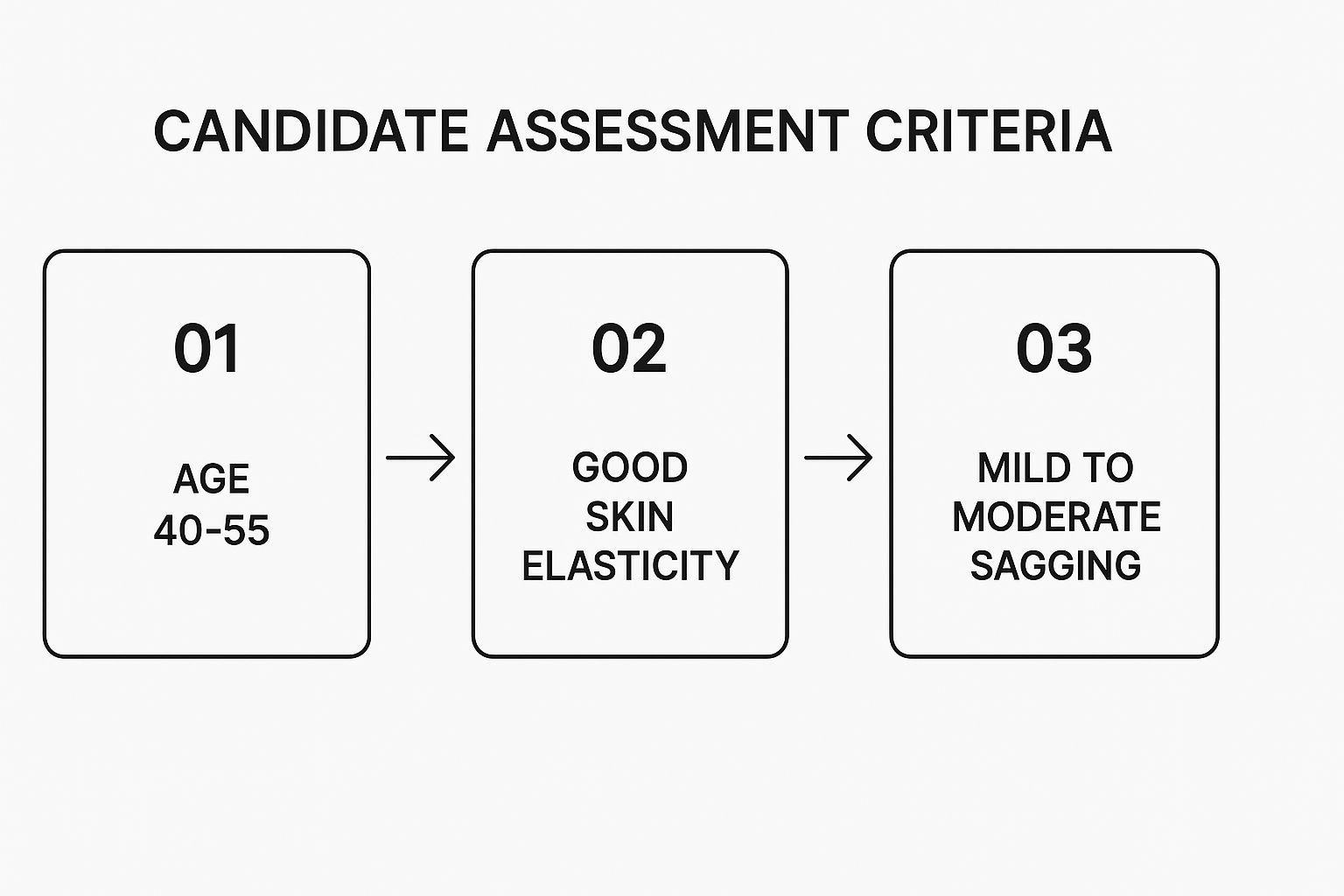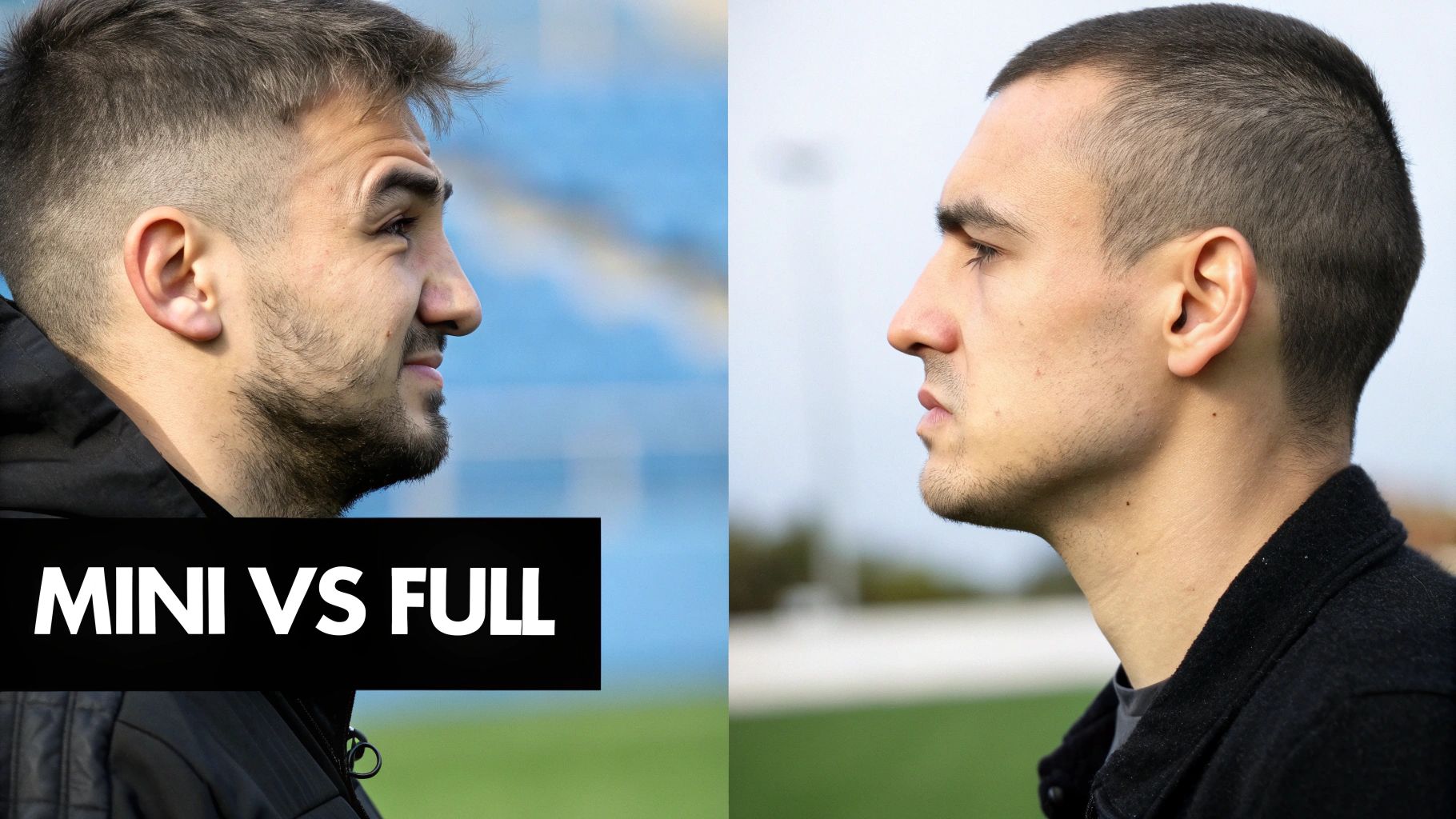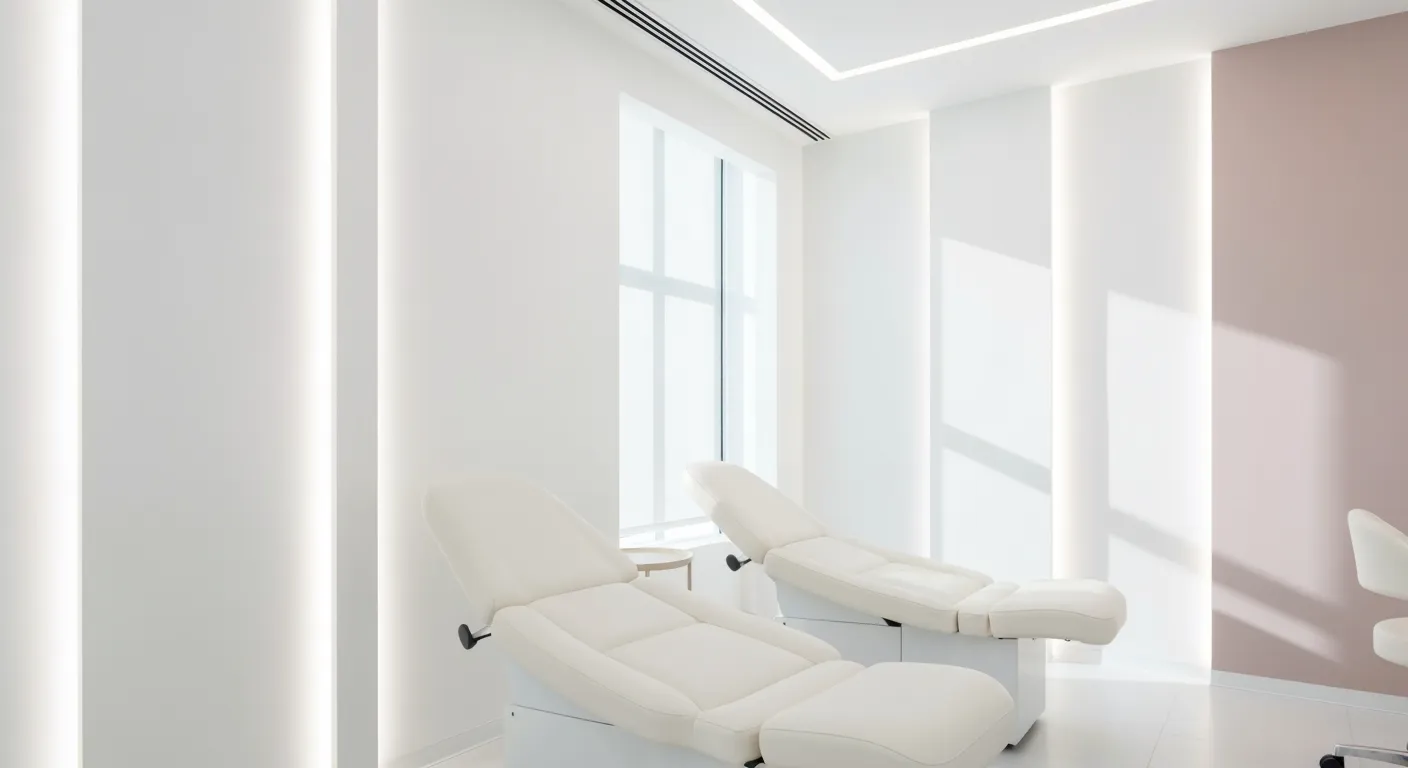
October 17, 2025
Breast Implant Size Guide: Find Your Perfect Fit
Discover our comprehensive breast implant size guide to choose the right CCs, profile, and shape. Make confident decisions for your ideal look!
Oct 16, 2025

You've started to notice some changes in the mirror. A little sagging along the jawline, maybe the beginnings of jowls that weren't there a few years ago. You don't need a massive overhaul, but a little "refresh" sounds appealing. This is exactly where the mini facelift comes in.
It’s a surgical procedure specifically designed to address those first signs of aging in the lower face. Think of it as a precise, targeted tune-up rather than a complete reconstruction. The goal isn't to change how you look, but to restore a more youthful, defined contour to your jawline with a much shorter recovery time than a traditional facelift.
Let’s use an analogy. If a full facelift is like a major home renovation—tearing down walls, redoing the foundation—a mini facelift is more like bringing in an expert to repaint, refinish the floors, and update the fixtures in a few key rooms. The result is a significant, beautiful improvement, but without the extensive downtime and disruption of a full-blown remodel.
This procedure focuses squarely on the lower third of your face. It's the perfect solution for people who are just starting to see age-related changes and want to get ahead of them before they become more pronounced. You’ll just look rested and revitalized, like you’ve had a fantastic vacation.

To give you a clearer picture, here’s a quick rundown of what a mini facelift involves.
This table breaks down the key features of the procedure into an easy-to-digest format.
As you can see, the procedure is designed for targeted results with minimal fuss.
The "mini" in the name really points to a few key advantages that make this procedure so popular. It’s not just a watered-down version of a full facelift; it’s a distinct technique with its own unique benefits.
A mini facelift isn't just about trimming away a bit of skin. The real art is in carefully re-draping the skin and tightening the underlying SMAS layer (the muscle structure of the face) to create a natural, refreshed contour that lasts.
The typical person who seeks out a mini facelift is often in their late 30s, 40s, or early 50s. They’re proactive, wanting to address the early signs of aging before they become more significant.
Looking at the numbers, women are the primary demographic for this type of procedure, making up 93% of all facelift patients, while men account for the other 7%. While this trend is common across most cosmetic surgeries, interest among men is definitely on the rise. You can explore more facelift trends and statistics from the experts at Elite Tampa. By catching facial aging in its early stages, a mini facelift offers a powerful way to achieve a subtle yet genuinely impactful result.
Thinking about a mini facelift is less about checking off a list and more about matching your personal goals with what the surgery can realistically deliver. It’s certainly not a one-size-fits-all fix, but for the right person, the results are fantastic. It’s designed to address very specific, early signs of aging.

So, who is that "right person"? Typically, it's someone who’s just starting to notice changes in the mirror—enough to bother them, but not enough to warrant the extensive correction of a full facelift.
The people who see the most success with a mini facelift tend to share a few key traits. Of course, everyone’s journey with aging is different, but this general profile can help you see if you fit the bill.
A mini facelift is perfectly suited for the patient who looks in the mirror and thinks, "I just want to sharpen my jawline and get rid of this early sagging." It addresses the "what if" before it becomes a major concern.
Just as important as knowing who this procedure is for is understanding who it’s not for. Recognizing the limitations of a mini facelift is the key to being happy with your results.
For instance, someone with significant loose skin, deep wrinkles, or heavy sagging that extends into the neck and mid-face probably won't get the results they want from a mini lift. These are bigger issues that require the more powerful, comprehensive approach of a traditional facelift, which can address the deeper tissues more thoroughly. A mini facelift simply isn't built for that kind of heavy lifting.
Knowing exactly what to expect during a mini facelift can take a lot of the mystery—and anxiety—out of the process. From that first chat with your surgeon to the day of the procedure itself, every step is carefully planned for your safety and to get the best possible result. Let's walk through what that journey looks like.
It all kicks off with a really important conversation: the consultation. This is your chance to lay out your goals, get all your questions answered, and make sure you click with your surgeon. They’ll take a close look at your facial anatomy, skin elasticity, and overall health to make sure a mini facelift is truly the right path for you.
Think of your consultation as a two-way street. Your surgeon will be very clear about what the procedure can and can't do. This is the time for you to be completely open about what you're hoping to achieve and voice any worries you might have.
Once you've decided to go ahead, you'll get a list of pre-op instructions. Following these is crucial for a smooth surgery and an easier recovery. You'll likely be asked to:
Taking these prep steps seriously sets the stage for a great outcome.
When you arrive for your mini facelift, the team’s top priorities are your safety and comfort. Most of these procedures are done with local anesthesia and sedation. That means you’ll be in a relaxed, twilight state—drowsy and pain-free, but not completely "out" like you would be with general anesthesia. This is a big reason why the initial recovery is often much faster than with more invasive surgeries.
The procedure itself is a finely tuned process:
The whole thing usually takes about two hours. Because the work is more focused and less extensive than a full facelift, there's less disruption to the surrounding tissue. This directly translates to a quicker, more comfortable recovery. If you're weighing your options, it can be helpful to learn more about the full range of facelift services available.

The real art of a great mini facelift isn't just about pulling the skin tight. It’s about repositioning the deeper support structures. That’s how you get a refreshed, natural look instead of that tight, "wind-tunnel" appearance.
Deciding to have a mini facelift is a big step, and knowing what to expect afterward is just as crucial as understanding the procedure itself. Think of your recovery as a journey with distinct phases, each one bringing you closer to your final, refreshed look. The best part? The relatively short downtime is one of this procedure's biggest draws.
Right after your surgery, your main job is simply to rest. You can expect some swelling, bruising, and a bit of tightness around your jawline and ears—this is completely normal and a sign that your body is starting to heal. Sticking to your surgeon’s post-op instructions is absolutely key during this initial period. For a comprehensive look at how to get set for your procedure and recovery, we've put together some great advice on how to prepare for surgery.
Recovery tends to follow a fairly predictable path. Knowing what's coming can make the whole experience feel much less stressful and a lot more manageable.
The First 48 Hours: This is when you'll see the most swelling and feel some discomfort. Your surgeon will prescribe medication to help you stay comfortable. All you need to do is relax with your head elevated, which really helps keep the swelling down.
End of Week One: By this point, you should see a big difference in the swelling and bruising. Many people feel good enough to switch from prescription pain medicine to over-the-counter options and start feeling more like themselves. Sutures are typically removed around the one-week mark.
Weeks Two to Four: As the last of the swelling goes down, you'll really start to see the early results take shape. Most patients feel ready to head back to work and their usual social routines after about 7 to 10 days, though you’ll still need to hold off on any intense exercise.
Patience is the name of the game during recovery. Your body is doing incredible work to heal, and even though a mini facelift has a quicker turnaround, giving yourself that time to rest properly is what guarantees the best possible outcome. Those subtle, natural results are absolutely worth the wait.
While you’ll see some exciting improvements within the first couple of weeks, the final, settled results of your mini facelift can take a few months to fully emerge. It just takes time for that last bit of residual swelling to disappear and for the tissues to soften and settle into their new, lifted position.
The end result is designed to be beautifully subtle—you’ll just look more rested and vibrant, not like you’ve had work done. This quicker bounce-back is a huge reason mini facelifts have become so popular, especially for busy professionals. Being able to get a refreshed look with a recovery that’s often just 7 to 10 days is a game-changer. This trend has only grown with social media, where people can see real patient results and get a better feel for the procedure, a phenomenon explored on plasticsurgery.org.
Ultimately, the goal is a crisper jawline and a more youthful contour that enhances your natural features without looking overdone.
Trying to decide between facial rejuvenation procedures can feel like a big decision. It really boils down to one simple question: are you looking for a subtle tune-up or a more significant overhaul?
I often tell my patients to think of it like home improvement. A mini facelift is like remodeling your kitchen—it makes a huge, noticeable impact on a specific area that's bothering you. A full facelift, on the other hand, is like a full-gut renovation of the entire first floor, addressing structural issues and creating a completely refreshed, harmonious look from top to bottom.

The biggest difference is simply the scope of the procedure. A mini facelift is laser-focused on correcting early to moderate signs of aging in the lower part of the face, especially softening the jowls and sharpening the jawline. A full facelift is a more extensive procedure designed to tackle advanced aging in the cheeks, lower face, and neck all at once.
To give you a clearer picture, let's break down the main distinctions. Seeing the procedures side-by-side is often the best way for patients to understand which approach might align with their goals and lifestyle.
As you can see, the more comprehensive results of a full facelift naturally come with a more involved procedure and a longer recovery. The right choice is always the one that fits your unique anatomy, your specific concerns, and what you hope to achieve.
For a more detailed exploration of the traditional procedure, our guide explaining facelift surgery techniques, recovery, and results is a great resource.
The most important thing to remember is that a mini facelift isn't just a "lite" version of a full facelift. It’s a completely different tool for a different job. It’s perfect for precisely targeting those first signs of aging, while a full facelift remains the gold standard for turning back the clock in a more significant way.
Let's talk about one of the biggest questions on everyone's mind: what does a mini facelift actually cost? It's not as simple as a single price tag; the final number is really a combination of a few key elements that all play a role in ensuring a safe procedure and beautiful, natural-looking results.
Think of it less like buying a product off the shelf and more like commissioning a piece of art. The total cost is built from several crucial components.
When you get a quote from your surgeon's office, it's not just an arbitrary number. It’s an all-inclusive figure that covers everything needed for your care from start to finish.
Here’s a look at what’s typically included:
It’s tempting to shop around for the best deal, but your choice of surgeon should always come down to their skill and credentials, not the price. Investing in a highly qualified surgeon is the best way to protect your health and ensure you get the outcome you're hoping for.
The idea of "medical tourism"—traveling to another country for a procedure—has become increasingly popular, largely because of the potential savings. You might find that a mini facelift in a country like Mexico or Thailand costs up to 80% less than it would in the United States or the UK.
While that price difference is certainly appealing, it's really important to do your homework. Standards of care, safety regulations, and surgeon credentials can vary dramatically from one country to another. For a deeper dive into these global cost differences, Bookimed.com offers a helpful breakdown. No matter where you decide to have your surgery, making sure your surgeon and facility are properly vetted is non-negotiable.
If you're thinking about a mini facelift, you probably have a lot of questions running through your mind. That’s completely normal. Getting solid, straight-to-the-point answers is the best way to feel confident about your decision. Let's tackle some of the most common ones we hear.
While a mini facelift can't stop the clock forever—the natural aging process will continue—it does turn it back quite a bit. Most people find their rejuvenated look lasts for a solid 5 to 10 years.
Of course, this can vary. Your genetics, how much time you spend in the sun, and your overall skin quality all play a part in how long you'll enjoy the results. It’s less of a permanent freeze-frame and more of a significant head start against aging.
This is a huge concern for almost everyone, and understandably so. The good news is that plastic surgeons are masters of camouflage. The incisions for a mini facelift are much shorter than those for a traditional one, and they're strategically placed along the natural contours of your ear or tucked away in your hairline.
Any surgery involves an incision, which means a scar. But the whole point of modern surgical technique is to make those scars fade so well that they become practically invisible once you're fully healed.
Most patients describe the feeling after surgery as tightness or discomfort rather than outright pain. You won't feel a thing during the procedure itself, as it's typically done with local anesthesia and sedation.
Afterward, any soreness is usually mild and easily handled with pain medication for a few days. Honestly, the recovery is known for being much more manageable and comfortable than what you'd expect from a full facelift.
At Cape Cod Plastic Surgery, Dr. Fater and our team believe in giving you clear, honest answers. If more questions pop up or you're curious to see if this is right for you, we'd love to sit down for a personalized consultation. Find out how we can help you reach your goals at https://ccplasticsurgery.com.

October 17, 2025
Discover our comprehensive breast implant size guide to choose the right CCs, profile, and shape. Make confident decisions for your ideal look!

October 17, 2025
Demystifying Plastic Surgery: Essential Insights for Prospective Patients

October 17, 2025
Your Guide to a Smooth and Speedy Recovery After Plastic Surgery